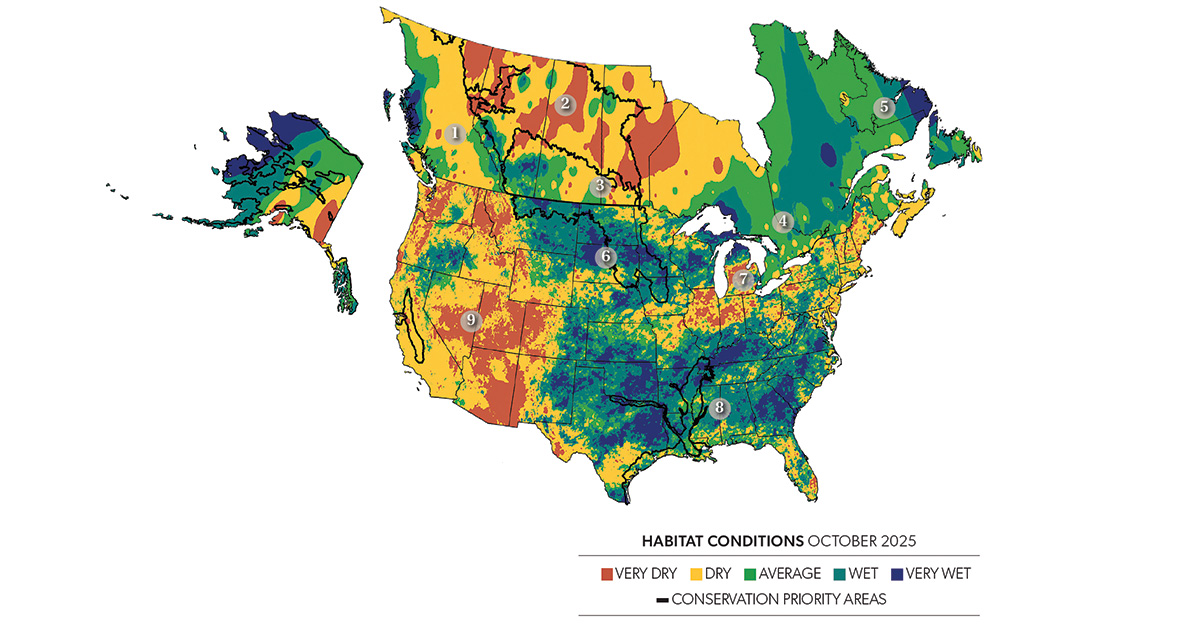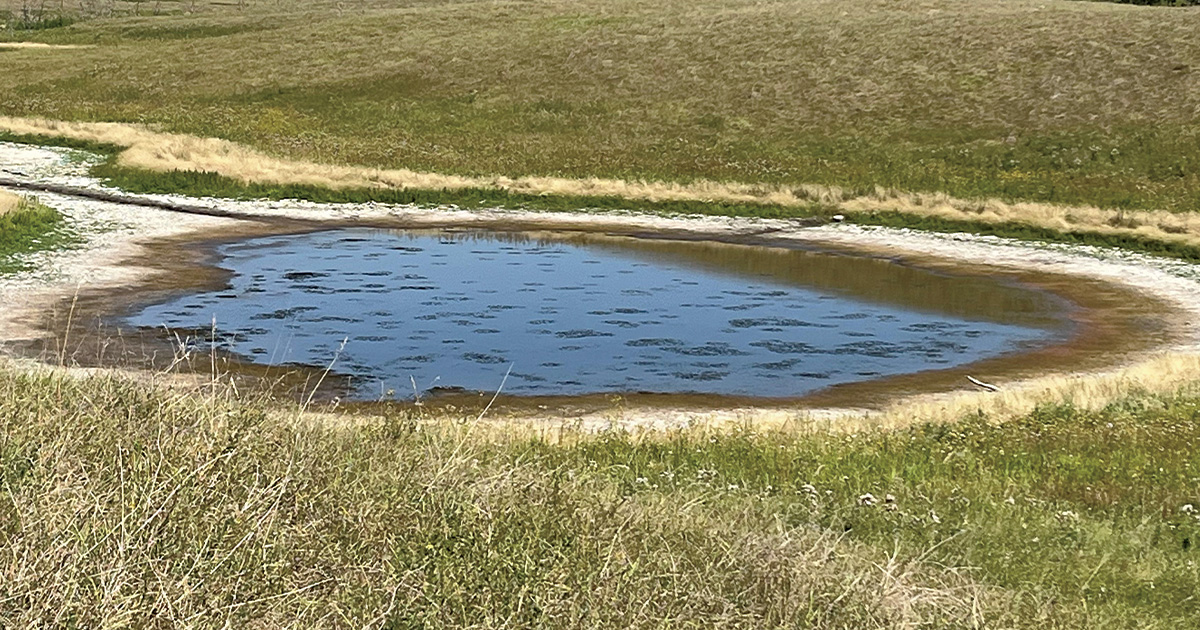Field Reports: 2025 Fall Habitat Outlook
An overview of wetland conditions on key migration and wintering areas
An overview of wetland conditions on key migration and wintering areas
By DU Field Biologists

DATA SHOWS PALMER DROUGHT INDICES WITH CATEGORIES CONSOLIDATED AND COLORED TO MATCH CURRENT CONDITIONS. CLIMATE ENGINE. 2025; DESERT RESEARCH INSTITUTE AND UNIVERSITY OF IDAHO. ACCESSED ON OCTOBER 1, 2025; CLIMATEENGINE.ORG. NOAA NATIONAL CENTERS FOR ENVIRONMENTAL INFORMATION AND AGRICULTURE AND AGRI-FOOD CANADA.
British Columbia experienced a dry summer with above-average temperatures. Low soil moisture and high evaporation rates have contributed to low water levels in the interior and northern regions. However, many larger wetlands are still holding water and providing habitat for migrating waterfowl. Wetland conditions are more typical along the southern coast, which received average to above-average precipitation. The fall migration was well under way in late September, with the first snow geese arriving along the coast.
Following a hot, dry summer, much of the Western Boreal Forest is still experiencing drought. Below-average habitat conditions in many staging areas prompted some duck species to begin their southward migrations earlier than usual. Significant snowfall will be needed over the winter to improve soil-moisture levels and wetland conditions next spring.

Although parts of Prairie Canada received beneficial rainfall this summer, most of the region remains very dry.
With persistent drought in northern and eastern parts of Prairie Canada, many seasonal and semipermanent wetlands are dry. Late-summer rains brought modest improvements, especially in southern Alberta and Saskatchewan, but most of the region needs substantial snowfall and spring runoff to recharge small wetlands, which are vitally important to breeding waterfowl. Permanent wetlands are providing crucial staging habitat for migrating waterfowl, and ducks and geese are concentrating on available water and feeding in harvested grain fields. Mild fall temperatures delayed the arrival of migrating waterfowl, which were still well below peak numbers in late September.
Hot temperatures and variable rainfall left many small wetlands in Ontario and Quebec with reduced water levels by summer’s end. However, larger wetlands have remained resilient and are providing essential staging habitat for locally raised and migrating waterfowl. A late-August cold snap triggered some migration activity, with Canada geese and blue-winged teal beginning their southward movements a bit earlier than normal.

Despite a lack of precipitation, larger wetlands continue to provide good habitat for staging waterfowl in Ontario and Quebec.
Summer was very dry in Atlantic Canada, and many watercourses and wetlands have receded to low levels. This has reduced the availability of wetland habitat on the landscape in many areas, but wild rice and other preferred waterfowl foods are plentiful in wetlands with good water levels, which could concentrate staging waterfowl this fall.
Across the Dakotas and northeastern Montana, timely summer rainfall alleviated drought conditions and kept the uplands green through September. Wetland conditions are fair in most areas, but biologists have observed dry and fully revegetated wetlands in parts of the Missouri Coteau. Southeastern North Dakota and northeastern South Dakota have received more frequent rainfall, which has recharged smaller temporary and seasonal wetlands, providing favorable habitat for staging dabbling ducks. As of late September, mild temperatures had delayed the arrival of migrating waterfowl, while locally raised birds were gathering on harvested grain fields and wetlands with abundant food resources.
Except for Wisconsin and northern Michigan, abnormally dry to extreme drought conditions prevail across the Great Lakes and northeastern states.Early field reports suggest fair to good numbers of blue- and green-winged teal on Great Lakes wetlands, but cool temperatures pushed some of the birds out prior to teal seasons. A heavy dose of precipitation is needed to improve wetland conditions in advance of the regular waterfowl seasons in many areas.

In south Louisiana and Texas, coastal marshes were in generally good shape for waterfowl heading into fall.
Intermittent summer rainfall has produced variable wetland conditions in coastal Texas and Louisiana. Coastal marshes are in generally good shape, but managed impoundments and agricultural fields are providing limited habitat due to persistent heat and dry weather. In the Mississippi Alluvial Valley and South Atlantic regions, a wet spring followed by a hot, dry summer has also created mixed habitat conditions. Excellent moist-soil production has been reported in managed impoundments with pumping capabilities, while a lack of rainfall has reduced water levels and food availability in other habitats. Significant precipitation will be needed across the southern United States to provide more favorable habitat for arriving waterfowl this fall.
Wetland conditions are highly variable across the West. The Klamath Basin supported large numbers of breeding waterfowl this summer, and conditions look good as fall approaches and early migrants arrive. The Great Salt Lake experienced a dry summer, which impacted impounded wetlands, and current lake levels are very low, with over 50 percent of the lakebed exposed. Waterfowl numbers are building on traditional staging habitats across the West, particularly as new areas are flooded for fall.
Ducks Unlimited uses cookies to enhance your browsing experience, optimize site functionality, analyze traffic, and deliver personalized advertising through third parties. By continuing to use this site, you agree to our use of cookies. View Privacy Policy